#long story short some European Presidents came to our museum
Explore tagged Tumblr posts
Note
omg hiiiii 💖
OMG HI MONY somehow I missed this in my notifications 💖💖💖 I am alive, work was killing me but I am alive and back dhdjhshs
#I've had to deal with the Secret Service all week#long story short some European Presidents came to our museum#it's been chaos shdjshsh#I've missed tumblr I need my silly website time#ems got mail#mutuals tag 💛✨
2 notes
·
View notes
Text
Day 152: Prague Castle (and the Window that Sparked a War)
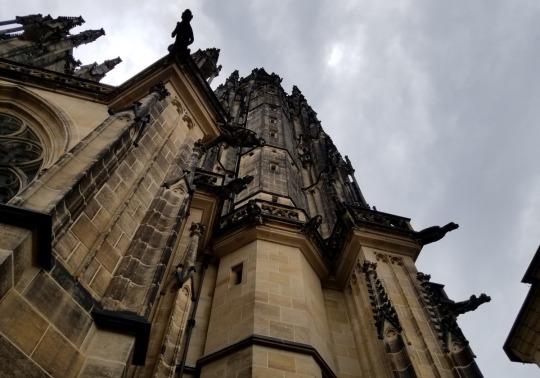
On our last day in Prague, the miserable heat that had been oppressing us throughout our stay finally broke. But it went out with a bang. It stayed above 80 degrees until after midnight and only fell to the mid 70s by morning, where it stayed for the rest of the day.
Still, it was bliss simply to wake up to a merely warm morning. At least, it was bliss for the first few seconds of consciousness I enjoyed before a wasp stung my hand.
I’d never been stung by a wasp before, and at first I didn’t know what happened. It was like a bolt of sheer electric pain coursing through my hand and up my arm. I managed to kill and flush the cursed thing (literally) before it could sting again or call for reinforcements.
I was able to wash and clean the puncture quickly--no real harm done--but my hand was throbbing and stiff for the rest of the day. Not a great start, but luckily things got better.
Prague Castle is on the far side of town from where we stayed, across the Vltava River. So, for the first time since we checked into our flat, we took the metro.
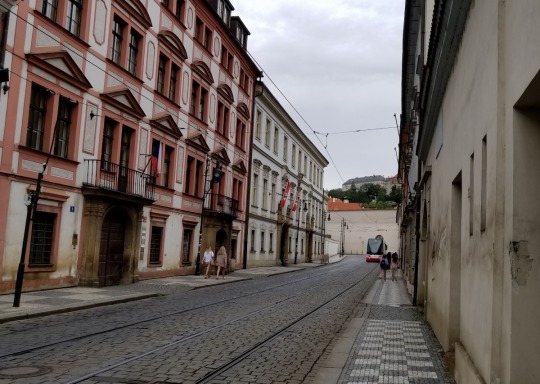

The metro doesn't go all the way to the castle, but that gave us a chance to enjoy a picturesque, if largely uphill, walk through the beautiful, shop-lined streets of the Castle District.


One of the shops was a Koh-i-Noor Hardtmuth--a major Czech pen, pencil, and art supply manufacturer. As a professional stationery fan, I had to go in.
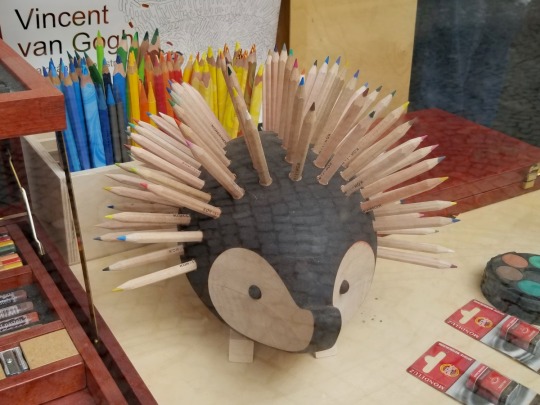

Meanwhile, Jessica entertained her own professional curiosity at a nearby gingerbread museum.
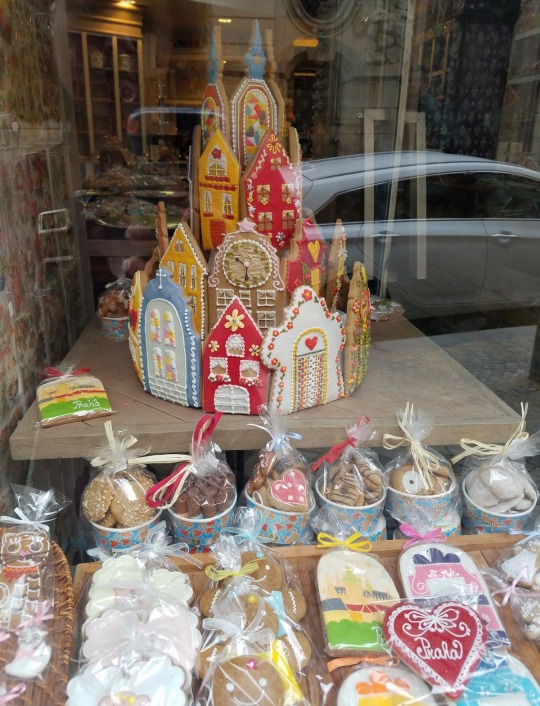
There were also a lot of shops selling puppets and marionettes. The Czech people apparently have a rich history of puppetry dating back to the middle ages.

That doesn't necessarily make them less creepy, though.
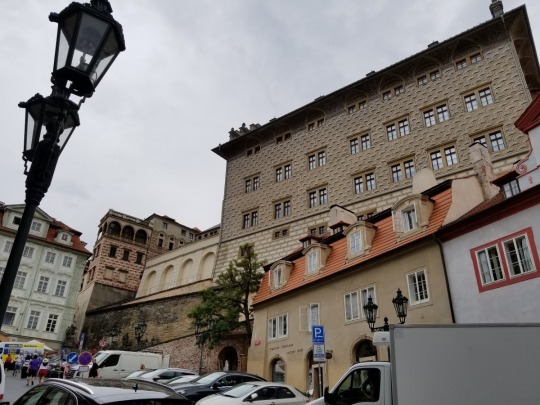

Once we made it to the top of the hill, we had a great view of central Prague. As well the surprisingly close Eiffel Tower.
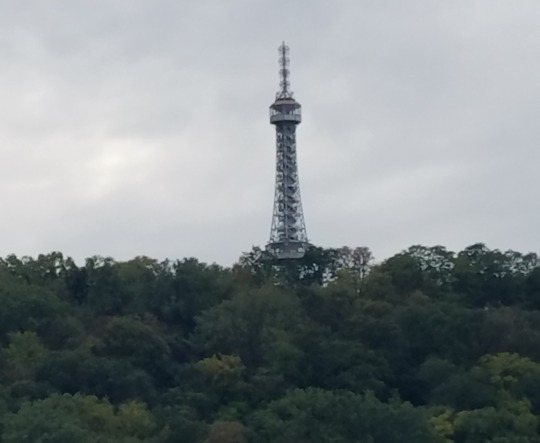
(It's actually the Petrin Lookout Tower, but it was directly inspired by the Eiffel Tower.)
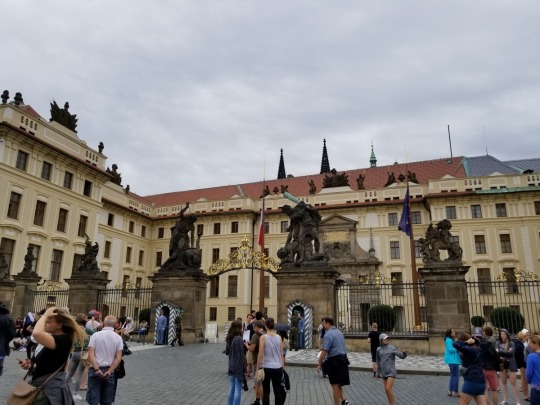
Prague Castle has been an important center of power for centuries--first for the medieval Bohemian kingdoms and later for the Austrian Habsburg empire that eventually absorbed them. It was also the home of the first president of Czechoslovakia after the country gained its independence in 1918.
It's also huge--a sprawling complex of palaces, churches, and squares. By some measures, at least, it is the largest castle on earth.


Outside the main castle complex is the Castle Square, lined with former palaces of important noble Czech families. One is still occupied by the Archbishop of Prague. Many of the buildings are painted with an interesting "envelope" pattern that gives the smooth plaster walls the appearance of being made of geometrically carved stones.
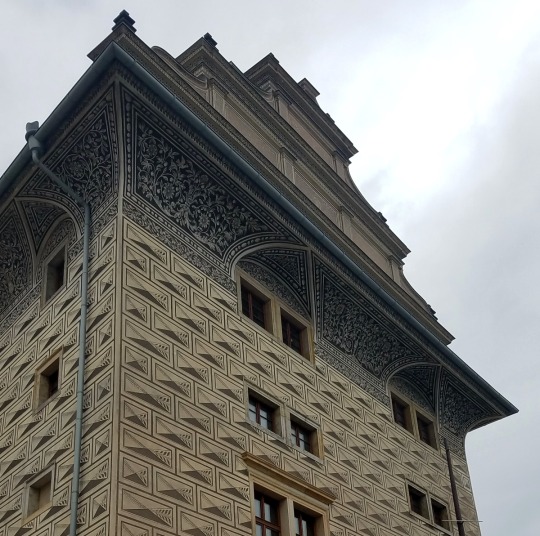

In the center of the square stands an elaborate column erected as thanks to God and Mary for ending a plague. It seems innocuous enough, but it is actually stands as a reminder of Prague's subservience to Habsburg Austria, which was were the tradition of erecting these Marian plague columns came from. After Czechoslovakia gained its independence in 1918, a similar column in the Old Town Square was torn down by a celebrating mob.
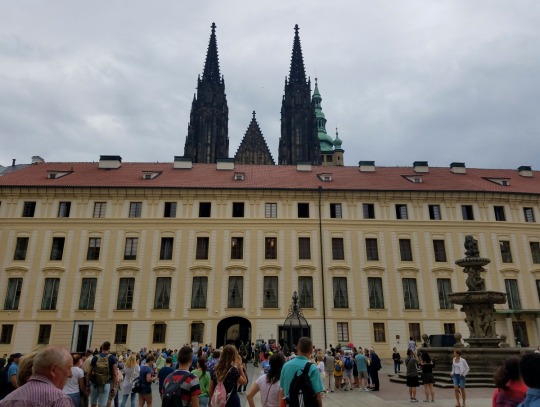
The castle grounds are free to enter as long as you don’t mind going through a security checkpoint. Once inside, you can buy tickets that cover various “routes” or sets of sights. When we got in, there was a huge line at the first outdoor ticket vendor. But the second ticket vendor, just inside a nearby building, had almost no one in line at all. Besides us.
(Thanks for the tip, Rick Steves!)
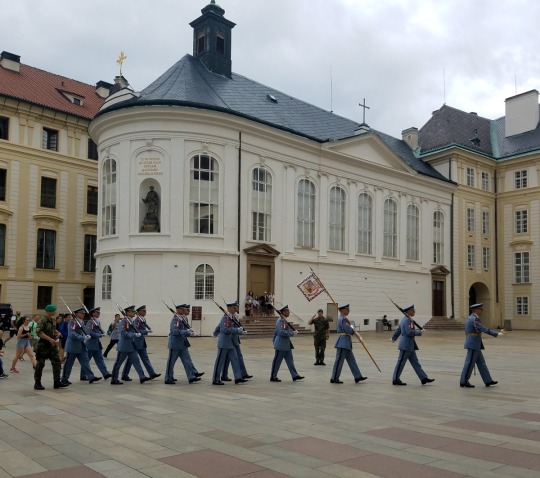
Just as we entered the middle courtyard, we got to see the changing of the guard.
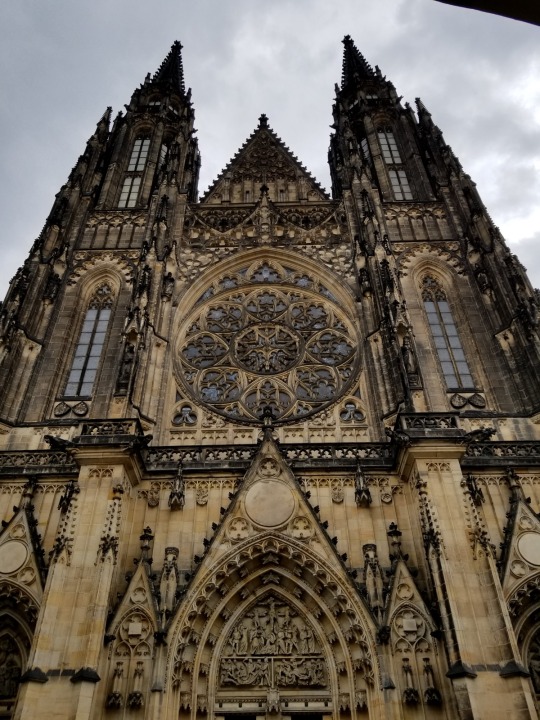
The centerpiece of the castle complex is St. Vitus cathedral. It is big and impressive like a national cathedral should be, and was also one of the slowest cathedrals to ever be built. It was started in 1344, and due to wars, plagues, and religious reformations, it wasn’t completed until 1929. You can see modern architects with business suits carved into the western facade–representing the men who made the final push to get the cathedral finished in honor of Czechoslovakia’s independence following WWI.

Besides its massive size, beautiful Gothic architecture, and everything else we’ve seen in so many other cathedrals by now, one of the coolest features to us was a stained glass window designed by–you guessed it–Alfons Mucha.
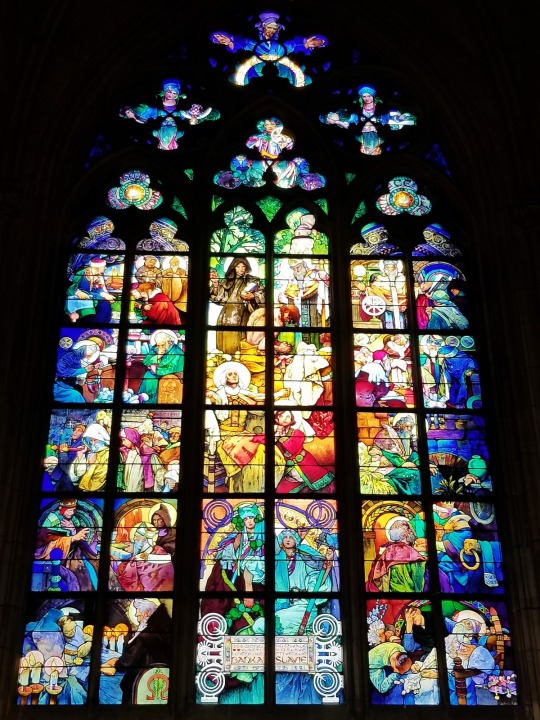
The center panes show a young St. Wenceslas being taught Christianity by his grandmother, St. Ludmila. The two young women at the bottom of the window represent the Czechs and Slovaks. And the sides tell the story of Saints Cyril and Methodius, two brothers who brought Christianity to the Slavic lands from Greece.

One of the brothers’ biggest problems in spreading Christianity was that the Slavs had no written alphabet. So Cyril, the younger brother, decided to invent one for them. Over the next few generations, that alphabet evolved into the modern Cyrillic alphabet, which is still used today in many Eastern European languages.
Sadly, the brothers’ lives didn’t go so well after that. When they returned to Rome to show the pope their new Cyrillic Bible, Cyril got sick and passed away. Methodius returned to Bohemia as an anointed bishop, but eventually a new pope came along and decided that the Cyrillic Bible was actually heretical. The church arrested Methodius and locked him away for years. He was eventually released, after which he spent the rest of his life quietly in a monastery.
So, if Wenceslas, Cyril, and Methodius are the three most-venerated Saints in Prague, why is the church named for St. Vitus, a 4th-century Sicilian boy who was boiled alive in tar?
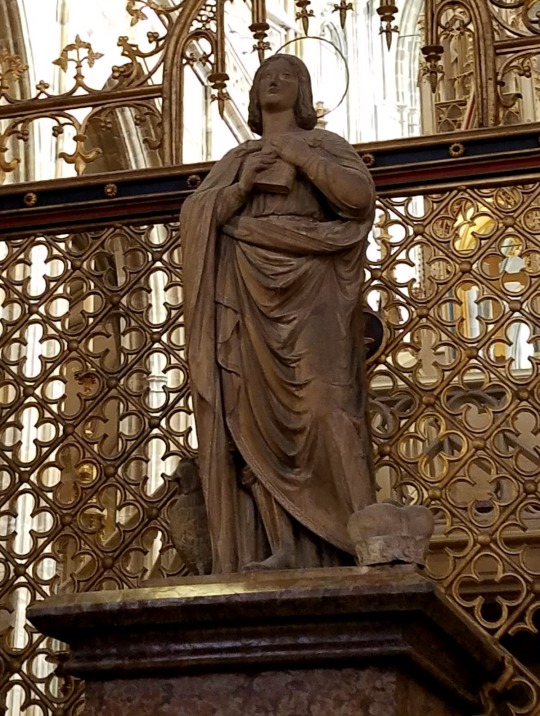
(The legend holds that a rooster was thrown into the vat of tar with Vitus as a sacrifice to the Roman gods, so Vitus is often depicted with a rooster at his feet. The legend also holds that Vitus was miraculously saved from the boiling tar. But not healed, so he still died--just later.)
In 925 AD, Duke Wenceslas--a Christian ruler of the still largely pagan Bohemia--received a relic of St. Vitus as a gift from the king of Germany. Wenceslas built St. Vitus Cathedral to house the relic, and it became an epicenter of Christianity in Bohemia.
It may have helped that the Slavic pronunciation of Vitus's name sounded a lot like the name of a pagan Slavic god.
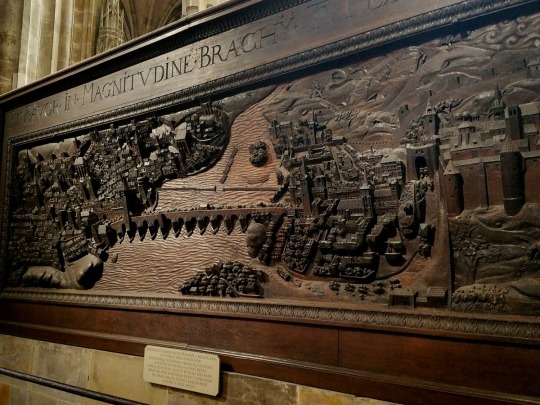
Other cool sights in the cathedral included a 400-year-old carving of the city of Prague as it stood in the early 1600s, as well as a massive silver tomb dedicated to another local saint: St. John of Nepomuk. John was a Bohemian priest who was murdered by King Wenceslas IV in 1396. The actual reason was most likely a disagreement over the appointment of a Benedictine abbot, but according to legend it was because John refused to divulge to the king what the queen had said to John during confession.
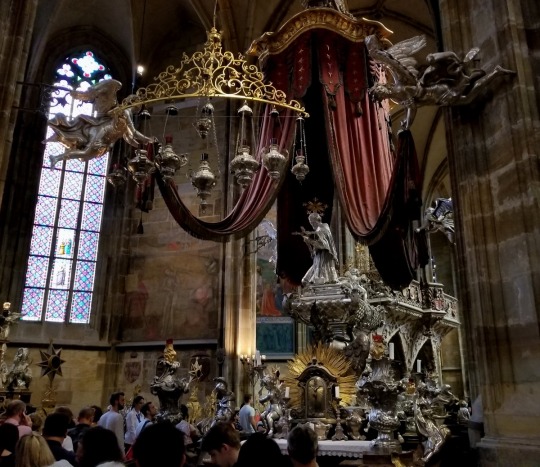
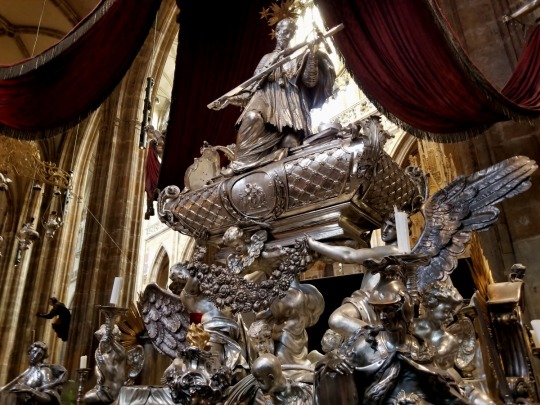
In any case, the tomb is staggeringly opulent. A huge crowd was gathered in front of it, and it was actually getting hard to move as we approached. Jessica was hit with a wave of claustrophobia and made her way through as quickly as she could, but I managed to stay behind a bit longer to get a good look.
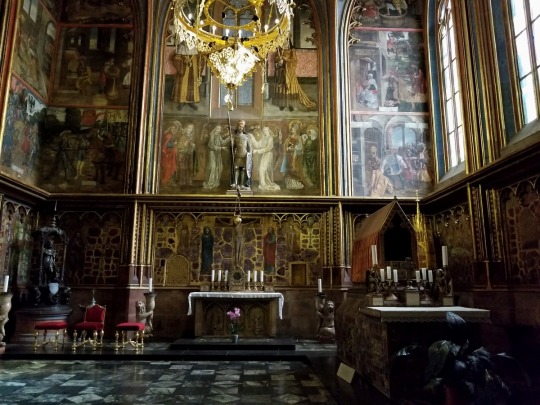
I also managed to get a peek into the gorgeous (and strictly cordoned) Chapel of St. Wenceslas, where the saint himself is entombed.
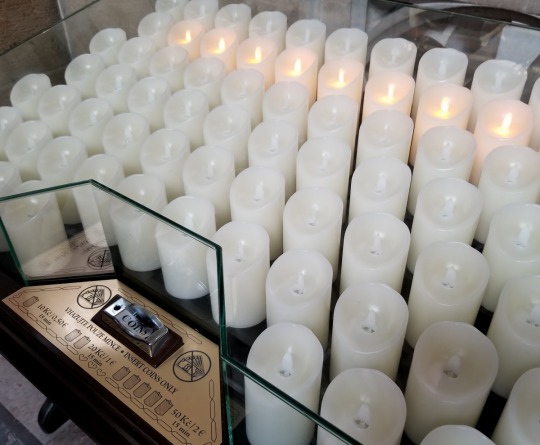
On our way out of the cathedral, we stopped for a moment to ponder the theological and economic implications of coin-operated electric votive candles.
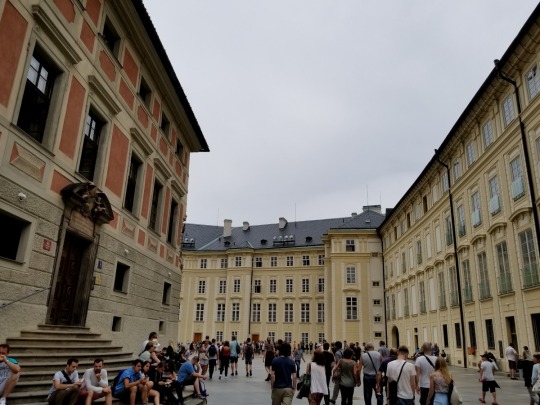
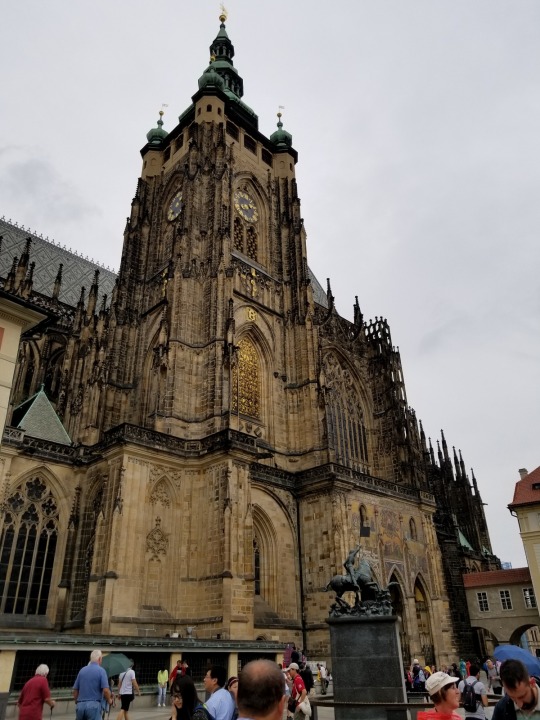

Back outside, we walked around the central courtyard to find the cathedral's spectacularly gilt south façade.

The next stop on the castle tour was the old royal palace. It was mostly empty, centered around a massive great hall that was once used for feasts, markets, and even jousting tournaments. Today, the palace holds the country's modest crown jewels, a throne room, and a room covered in painted coats of arms.
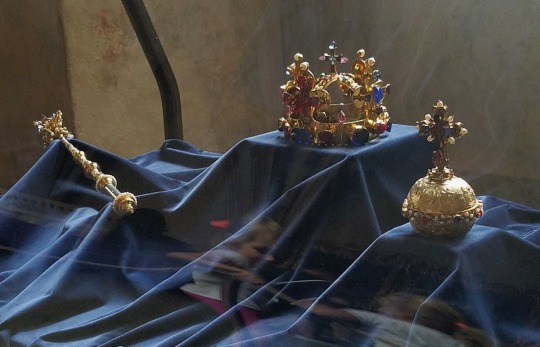
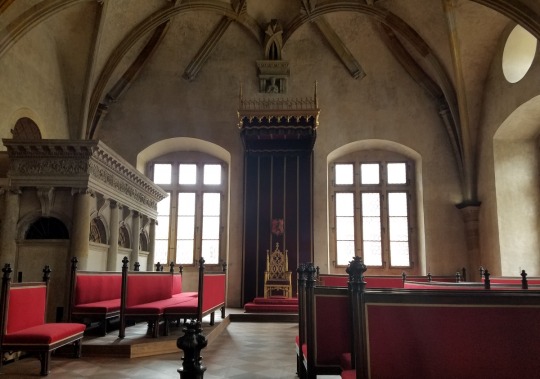
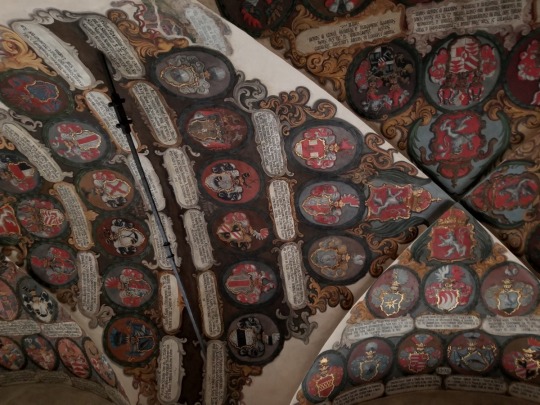
But the most important thing in the palace is a window. A window that helped spark the one of the bloodiest conflicts in all of European history--the Thirty Years’ War.
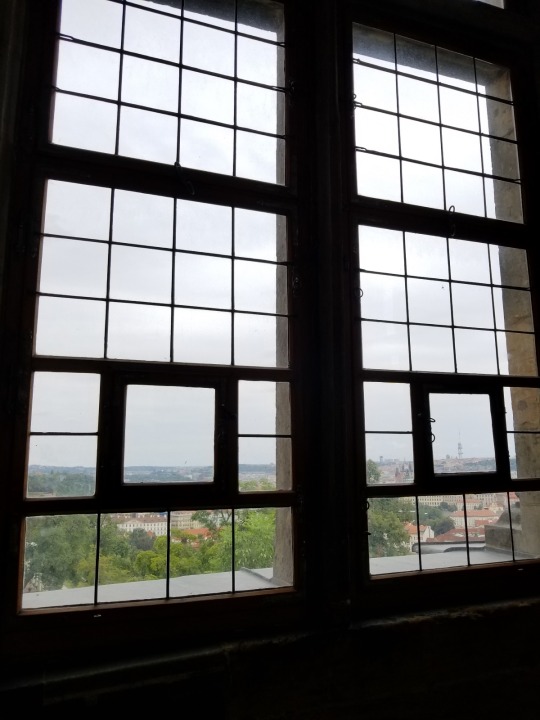
One of the few things I still remember from my high-school European History class is the Defenestration of Prague. Mostly because it taught me the word "defenestration."
Defenestration: (Noun) The act of throwing someone out of a window.
To me and all the other kids in the class, that was fantastic. In reality, of course, it was deadly serious.
Long story short: It is 1618. Under the terms of the Augsburg Settlement, rulers within the Holy Roman Empire could choose whether their state would be Protestant or Catholic. Bohemia is an Imperial state, and its rulers are Catholic. But much of Bohemia's nobility is Protestant, and they're tired of being ruled by Catholics.
So, following in the tradition of the Hussites 200 years earlier, the nobles go to Prague Castle and throw the Catholic rulers out of a window. One thing leads to another, alliances are invoked, opportunists join the fray, and soon all of Europe is embroiled in a brutal, convoluted war that kills millions--mostly German civilians caught in the middle.
In the hardest-hit German states, over half the pre-war population die by violence, plague, or starvation before the war ends.
The Peace of Westphalia--a series of treaties that finally ended the Thirty Years’ War in (appropriately) 1648--is seen by many as the beginning of the age of sovereign nation-states.
It’s kind of crazy to me that the idea of countries being independent entities with precisely defined borders and their own separate governments is only four or five hundred years old. But it’s true. Throughout the Middle Ages, Europe was more like a chessboard, with squares constantly being traded back and forth into increasingly large and convoluted hierarchies. A single marriage could join two countries together, and a single death could tear them apart again. One man could be the king of England, an heir to the throne of France, and also the descendant of a French duke. Does that make England part of France or France part of England? It took five generations of war to decided that the answer was “neither.”
You can’t really understand medieval and early-modern politics without adopting a much more fluid sense of what a country actually is. It’s still really hard for me to do, and I’ve spent a lot of time trying.
Anyway...



After the royal palace, we visited the Basilica of St. George--an old Romanesque church that served as the royal chapel before the construction of St. Vitus Cathedral. It is smaller, less crowded, and more intimate than St. Vitus. Among the old Czech rulers buried there is St. Ludmilla, St. Wenceslas's grandmother and the first Christian ruler of Bohemia along with her husband Bořivoj.
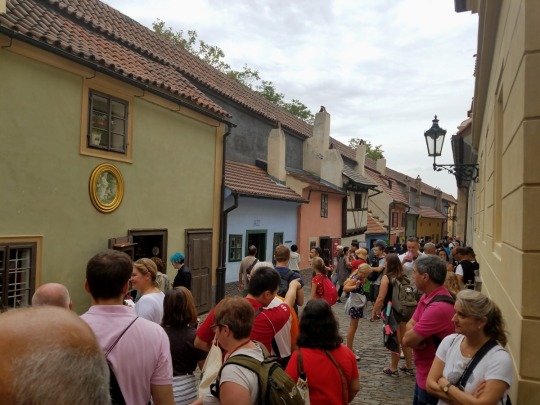
Our tickets gave us access to one more sight as we left the castle: a medieval shop-lined street called Golden Lane. The name comes from the goldsmiths who used to work their and serve the castle's opulent needs, but today it houses a wider variety of shops and museums. There were jewelry shops, of course, and a puppet shop that creeped Jessica right out.


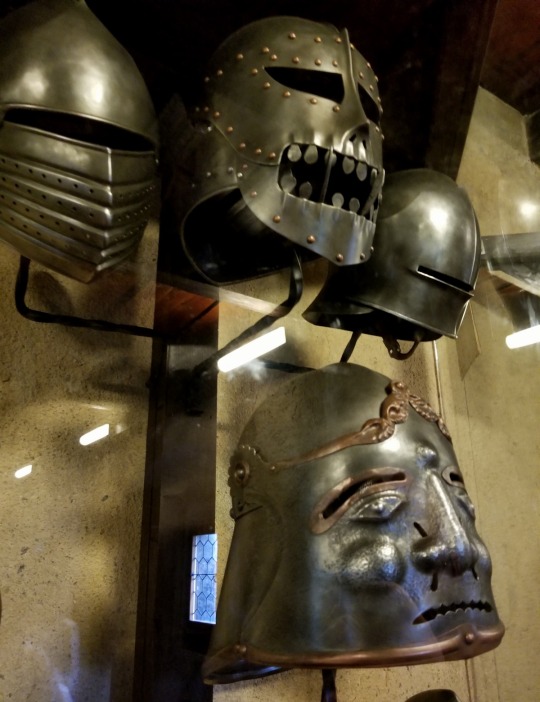
The coolest part for me was a showcase of medieval arms and armor, which was housed in the long attic that ran across the length of the street. Jessica found it immediately claustrophobia-inducing, so I stayed back to take pictures while she went on to look at the other shops along the lane.
Having made it from one end of the castle to the other, it was time for us to decide what to do next. There was the highly recommended Lobkowicz Palace--home to the oldest and largest private art collection in the Czech Republic--but Jessica and I had been around enough at this point to know that we didn't have another museum visit left in us that day.
The option we had in mind was a visit to the monastic brewery of Pivovar Strahov. It may have been considerably cooler than the previous days, but we had still worked up a strong thirst walking around the castle. Some traditionally brewed beer from a 17th-century monastery sounded like just the right way to cap off our stay in Prague.
Of course, that meant turning around and walking all the way back up through Prague Castle and another half-mile uphill beyond. It was worth it, though.

I'd wanted to try their "most award-winning" dark lager, but sadly it was sold out. So instead, I opted for their mainstay amber lager. Jessica chose from the more adventurous seasonal menu a coconut wet-hop ale.
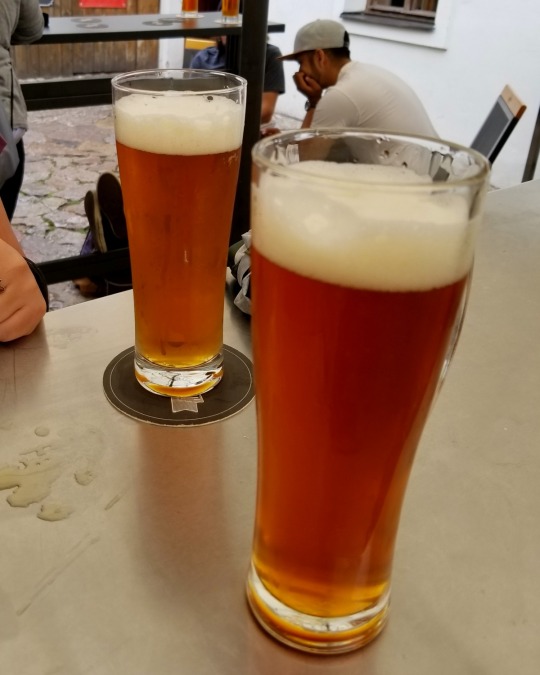
Both were good, but we each preferred our own choice.
Thoroughly spent, we called an Uber to take us back to our flat. Jessica tried to make small talk with the driver, but he cut her off with a cursing tirade against an aggressive cyclist on the road. Typical Slavic conversation atmosphere.
Overall, Prague was one of our most challenging cities, but it also left us wanting more. Even five perfect days would not have been enough, and with so much heat and so little sleep, we had been at a significant handicap. So instead of pushing ourselves to see one last thing, we contented ourselves to an early evening and an eager desire to return--preferably during spring.
Next Post: To Vienna
Last Post: The Slave Epic (and a Break for Beer)
6 notes
·
View notes
Text
France’s epic Bayeux Tapestry is headed to Britain, in a loan for the ages
By William Booth and James McAuley, Washington Post, January 18, 2018
LONDON--It is probably the most famous piece of medieval embroidery in the world, a ribbon of scrolling tapestry 70 yards long that tells in pictures the story of the Norman Conquest of England in 1066, an epic tale of gore, glory and God.
There is nothing quite like the Bayeux Tapestry, a near-cinematic work of narrative genius. President Emmanuel Macron’s announcement Thursday evening that his government will allow the priceless treasure to leave France for the first time in almost 1,000 years to be exhibited in Britain is a sensational stroke of cultural diplomacy.
The statement came at the close of bilateral talks with British Prime Minister Theresa May at the Royal Military Academy at Sandhrst. Thanking Macron, May said, “I am honored at the loan of such a precious piece of our shared history which yet again underscores the closeness of our relationship.”
She said the work would come to Britain in 2022.
For the British, the Bayeux Tapestry holds a powerful allure, since the Norman Conquest represented not just a tragedy and a defeat but a pivot point that essentially transformed Anglo-Saxon society into the Great Britain of today (and gave us the language of Shakespeare).
The 20-inch-wide, intricately stitched work is a history and morality play--unfolding chronologically from left to right, with a couple of flashbacks--about how the heroic but flawed Harold, Earl of Wessex, briefly took the throne after the death of the heirless Edward the Confessor, only to be defeated a month into his reign by the righteous William, Duke of Normandy, at the climactic Battle of Hastings.
As William Faulkner wrote: “‘The past is never dead. It’s not even past.” A descendant of William the Conqueror sits on the British throne today, 91-year-old Queen Elizabeth II.
The last formal request by Britain to have the tapestry on loan came ahead of Elizabeth’s coronation in 1953. The Bayeux Museum declined. Another entreaty in 1966 for a loan to mark the 900th anniversary of the Battle of Hastings was also rebuffed.
The fragile tapestry is currently on display in its own specially designed conservatory at the Bayeux Museum, which is in northern France not far from the Normandy beaches of the D-Day invasion. British visitors make up the largest contingent of pilgrims wanting to see it.
In a statement, the Bayeux Museum appeared a little reluctant to let the tapestry go, stressing that the needlework masterpiece may need to be stabilized before it is moved, would probably not be ready to travel until 2023 and should then be allowed to stay in England for no more than a year.
Either way, fans of the Bayeux embroidery were giddy at the prospect of its appearance in Britain, with various museums and their political patrons already competing to host the show.
“This is a work that can only be spoken of in superlatives,” said Andrew Bridgeford, a lawyer, a historian and author of “1066: The Hidden History of the Bayeux Tapestry.”
Bridgeford noted the work’s enormous scale, the richness and detail of the story it tells--”these simple drawings in yarn that seem very naive but are not”--and the lingering mysteries surrounding its creation. “There’s really nothing like it,” he said.
Not everyone in Britain was as thrilled about the second coming of the tapestry--not least because it chronicles a crushing defeat.
John Redwood, a Conservative Party lawmaker and a hard-line advocate of Britain’s exit from the European Union, blasted out a volley of tweets.
“While I’m sure the offer is well meant, I will pass over the unfortunate truth that it depicts an invading French army killing England’s King & many in his army before taking over,” he wrote.
He then alluded to Brexit, warning the French leader that the Battle of Hastings “was the last time England was defeated in war by a hostile continental invasion, though many more attempts were made at enforced political union with the continent.”
Philippe Plagnieux, a professor and specialist in medieval art history at the Sorbonne in Paris, said: “Without doubt, it has tremendous political significance, but I think for many it’s a fascinating object, a grand succession. The details alone--the elements of daily life, the concrete things it shows--that’s incredibly rare for the period, and it’s absolutely unique.”
Not only is the tapestry extraordinary, so is its mere survival: The wool yarn embroidered on linen has bested both moths and Nazis.
During the French Revolution, the panels were to be confiscated to cover military wagons, but they were rescued by a local lawyer.
Napoleon took the tapestry to Paris and paraded before it as he contemplated an invasion of England.
Because of its depiction of the Norman Conquest--by the descendants of Norsemen or Vikings--the Nazis coveted the tapestry as Aryan propaganda.
Before the Allied invasion of France in World War II, the Germans moved the tapestry to occupied Paris to safeguard it along with their other loot in the Louvre. The SS chief, Heinrich Himmler, wanted the Bayeux masterwork to decorate his medieval castle in Germany.
Just hours before the Allies swept into Paris, British code-breakers intercepted a signal from Himmler to his troops ordering them to snatch the tapestry--but they were repelled by French resistance fighters who took up positions at the Louvre.
The panels read as a kind of medieval page turner, a cartoon of treachery, revenge, honor, guts and glory. There are scenes of feasts (chickens on spits) and an ominous apparition (Halley’s comet). There are depictions of shipbuilding, dangerous voyages, falconry and funerals, quicksands, looting and pillaging, and sexual scandal (complete with an image of a naked man).
The battle that raged at Hastings is the centerpiece. It shows a field littered with headless torsos and strewn corpses, where a king falls not with an aristocratic sigh but an arrow through the eye.
The flat-bottomed vessels are built of overlapping planks. They resemble the Viking ships they were modeled upon.
The men--nobles, cavalry and foot soldiers--are dressed in knee-length tunics. The English are hairier than the Normans. Normans and Anglo-Saxons sport haircuts that resemble today’s mullet, long on top, short on the sides.
There are 626 human figures, 190 horses and 35 dogs, alongside 506 short inscriptions in Latin. Three women are shown. In one scene, they are fleeing a burning building.
Who sponsored the work? The consensus view, said Richard Gameson, professor of early medieval art and manuscripts at Durham University, is that the tapestry was most likely created not in France but in England, just a few years after the 1066 Battle of Hastings.
Most scholars suspect that William the Conqueror’s half brother, Bishop Odo of Bayeux, commissioned the piece, although no one knows and there are other intriguing possibilities. Indeed, William’s Norman lords, and the Anglo-Saxons who backed him, became landed millionaires, even billionaires, by today’s standards.
Alas, the designer’s identity is also lost to history. Although Gameson said it could have been a monk, as some argue, he suspects it was someone more worldly, who had traveled widely and was familiar with the look of contemporary ships, weapons, horse tack, architecture and court life.
Who stitched the nine panels? Many hands. But it is unknown whether the embroiderers were men or women or both. At the time, Gameson said, embroidery was “a high-status occupation” pursued by experts of both sexes.
One of the notable elements of the narrative of the Bayeux Tapestry is how evenhanded it is. It was clearly created by the victors to represent the Norman side of things. But it also portrays the vanquished Harold as a noble and brave king.
“The tapestry shows Harold as a worthy foe and the English as ferocious fighters,” Gameson said. “And so the victory is hard-won. It is earned.”
But the tapestry suggests, too, that William won by divine right. Harold was the usurper to the throne, it appears to argue, and William the rightful heir.
There is a literal hand of God shown here, a cross emblazoned on a Norman ship there. “The signs are subtle to us,” Gameson said. But to its audience in the 11th century, the message would have been clear: The right guy won.
2 notes
·
View notes
Text
Hyperallergic: Required Reading
This past week, the National Oceanic and Atmospheric Administration released images taken by its recently launched GOES-16 satellite. With its high-definition camera, the satellite shows our planet in vivid detail. (images by NOAA, via NY Times)
What happens when a major art museum throws out your art work? Well, New York sculptor Pat Lasch had that exact experience at the Museum of Modern Art. Randy Kennedy writes:
Recently Ms. Lasch, 72, discovered a mistake that even the loveliest rose is unlikely to fix: The Museum of Modern Art, which commissioned a 5-foot-2-inch-tall cake sculpture in 1979 as part of its 50th anniversary, appears to have discarded the piece, which Ms. Lasch wanted to borrow for a retrospective of her work opening in March at the Palm Springs Art Museum in California.
Ms. Lasch, a first-generation feminist who started working in the early 1970s, said she contacted the Museum of Modern Art last fall after the curator in Palm Springs, Mara Gladstone, was unable to find records of the cake sculpture in the archives at MoMA. “Mara said, ‘Pat, I don’t know how to tell you this,” Ms. Lasch recalled in a recent interview.
A 32-year-old freelancer from Queens, Munira Ahmed, has become the face of resistance to the Trump administration. Her face was used by artist Shepard Fairey (the artist best known for his Hope poster for Obama’s 2008 campaign) for his new poster:
“It’s an honor because of what the picture represents,” Ahmed said. “It’s not anti-anything. It’s about inclusion. It’s about saying, ‘I am American just as you are.’”
At the march in Washington, Ahmed said, “one congresswoman came up to me and said she knew immediately that the woman in the picture was me. I was surprised because I assumed people would think it was someone who covered [with a hijab] and I actually don’t.
“One group of girls asked me when I stopped covering, and I told them I never did.”
The real story about the Churchill bust in the Oval Office:
The Churchill bust story has been a constant source of poor reporting. Sometimes it is incorrectly reported that Blair made the loan of Bust B in the wake of the Sept. 11, 2001, attacks, when in fact he made it two months earlier. Meanwhile, the Obama White House for years misled reporters about whether the president had a hand in the decision to return the bust. Clearly, Obama misunderstood the symbolism of removing the bust from the Oval Office and was embarrassed to admit it.
Why African photographers don’t get to tell African photo stories in Western media:
If the construction of the African as child-like, or not quite human, who has little agency or intellect, aided the colonial project, today, the narrative continues to aid the construction of the European self as civilised, maintaining the African and Africa as the location of savagery, helplessness, and devastation. It also creates Europe as a desirable location that those who have no agency and have done little to better themselves attempt to infiltrate – much to Europe’s chagrin.
Aida Muluneh, Ethiopian-born artist, documentary photographer, and the founder of Desta for Africa (DFA) – a creative consultancy that curates exhibitions and pursues cultural projects with local and international institutions – emphasises: “Photography continues to play a key role in how we are seen, not just as Africans, but as black people from every corner of the world. Stereotypes and prejudice are incited by images, and if it’s used, yet again, to undermine those of us who are truly doing the difficult work, then we need to have some uncomfortable conversations.”
87% of UK freelance photogs asked to work for free in 2016; 16% said yes:
The study “reveals an alarming trend for corporate ‘entitlement’ when it comes to how freelance professionals are treated,” Approve.io tells PetaPixel.
Of all freelancers across all industries (e.g. photography, writing, design), 70% of people were asked to work for free, and 10% said yes. So it seems that photographers have a higher rate of being asked for free services (and agreeing to those requests) compared to other types of creatives.
A century ago, a group of bohemians in Manhattan declared Greenwich Village “The Free and Independent Republic of Washington Square,” even taking over the arch in the middle of Washington Square Park to prove their point. Here’s some more info about that unusual event:
At the time, the Village was still a bohemian paradise (rather than today’s ritzy neighborhood that uses its artistic legacy as a marketing tool), home to artists and playwrights and others who moved against the grain of conventional American society of the time. Some of the artists of the day—including surrealist Marcel Duchamp and painter John Sloan—decided to further affirm the neighborhood’s countercultural bona fides by staging a coup, of sorts, of the Washington Square Arch, and proclaim its independence from the rest of Gilded Age, capitalist New York City.
Researchers showed the Obama 2009 and Trump 2017 inauguration photos of the Washington Mall to partisans and, as expected, they saw what they wanted:
For the question about which image went with which inauguration, 41 percent of Trump supporters gave the wrong answer; that’s significantly more than the wrong answers given by 8 percent of Clinton voters and 21 percent of those who did not vote.
But what’s even more noteworthy is that 15 percent of people who voted for Trump told us that more people were in the image on the left — the photo from Trump’s inauguration — than the picture on the right. We got that answer from only 2 percent of Clinton voters and 3 percent of nonvoters.
Combining the Trump administration and the classic Watchmen graphic novel is strangely appropriate:
An old film strip made by Soviet artists in 1960 that envisions life in the year 2017:
No one expected the National Park Service to be such a strong voice in resistance to the Trump administration, yet here we are:
In his first days in office, Donald Trump has made a point of censoring and restricting what the National Park Service can and cannot say on its various official Twitter accounts. After the NPS tweeted photos of Trump’s small inauguration crowd, he temporarily suspended its Twitter privileges. And when the Badlands tweeted about climate change today, those tweets were then deleted. But now some unnamed individuals within the National Park Service have created an unofficial Twitter account that Trump can’t touch.
Here is the alternative US National Park Twitter account (@AltNatParkSer).
Required Reading is published every Sunday morning ET, and is comprised of a short list of art-related links to long-form articles, videos, blog posts, or photo essays worth a second look.
The post Required Reading appeared first on Hyperallergic.
from Hyperallergic http://ift.tt/2kBTzCK via IFTTT
0 notes